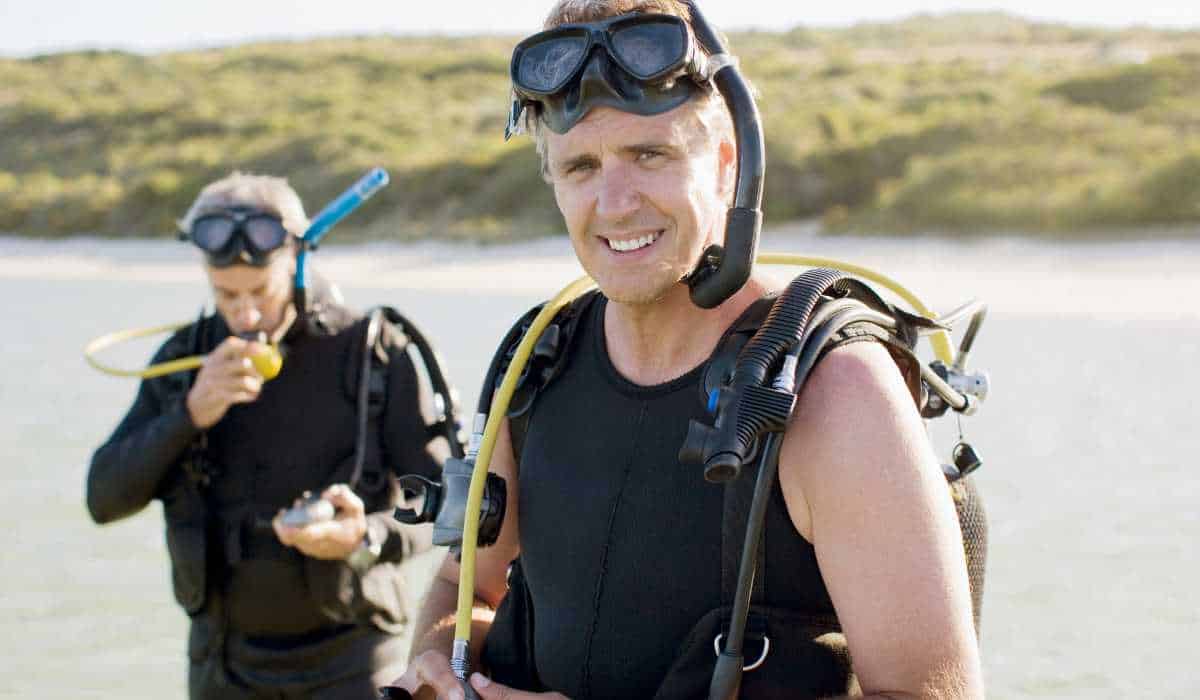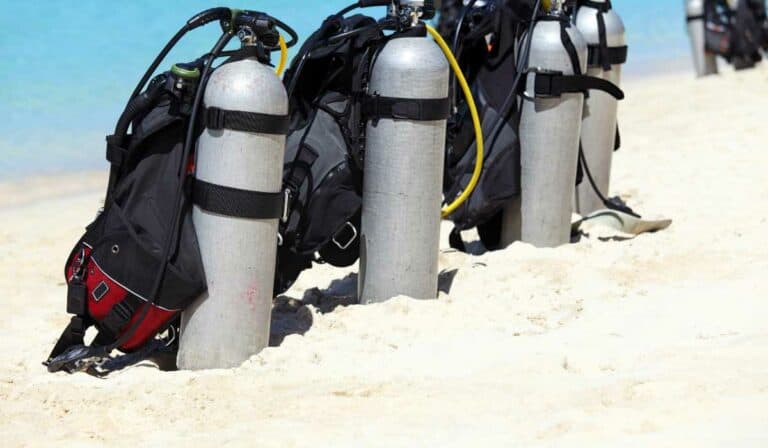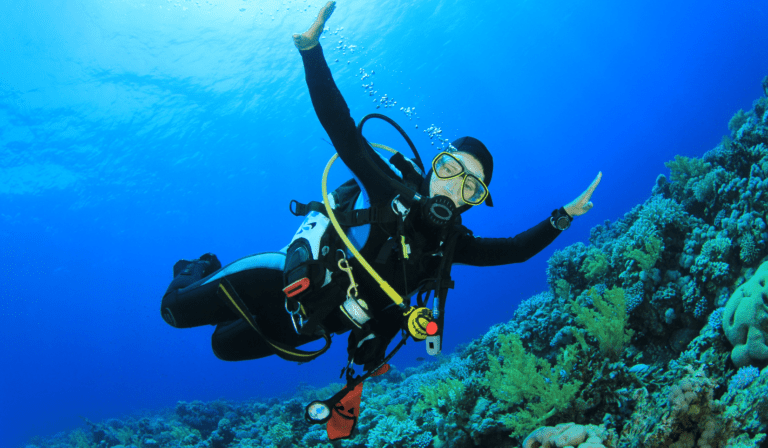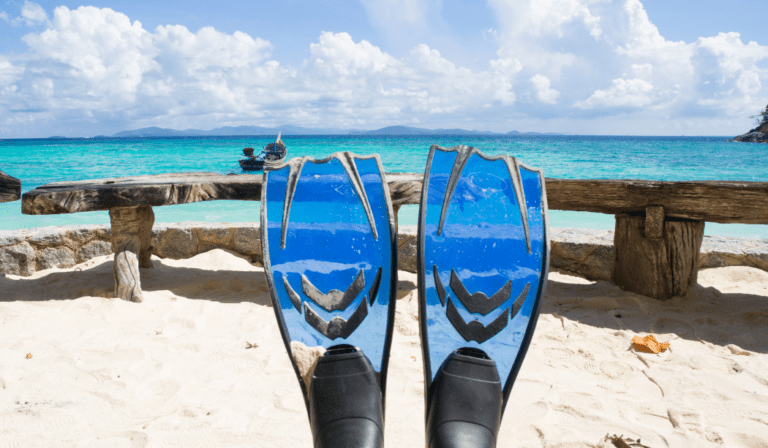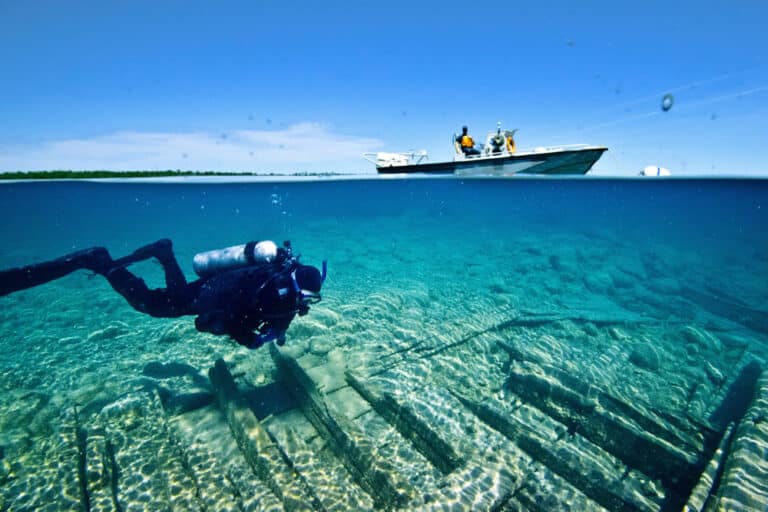The History of Scuba Diving: Origins and Evolution
Diving into the history of scuba diving reveals a fascinating journey of human innovation and exploration. From ancient techniques to modern advancements, scuba diving has transformed from a challenging endeavor to an accessible recreational activity for millions worldwide.
In this post, we’ll investigate the roots of scuba diving, with a focus on those who made notable strides in aquatic exploration. We will also discuss the evolution of scuba gear that enabled divers to safely explore deeper depths and remain submerged for extended periods.
As you continue reading, you’ll discover popular destinations that attract recreational divers seeking adventure and unique underwater experiences. Finally, we will provide essential safety tips for both novice and experienced divers alike in order to ensure enjoyable dives while minimizing risks associated with this thrilling pastime.
Let’s explore the fascinating background of scuba diving!
Table of Contents
1. Exploring the Origins of Scuba Diving
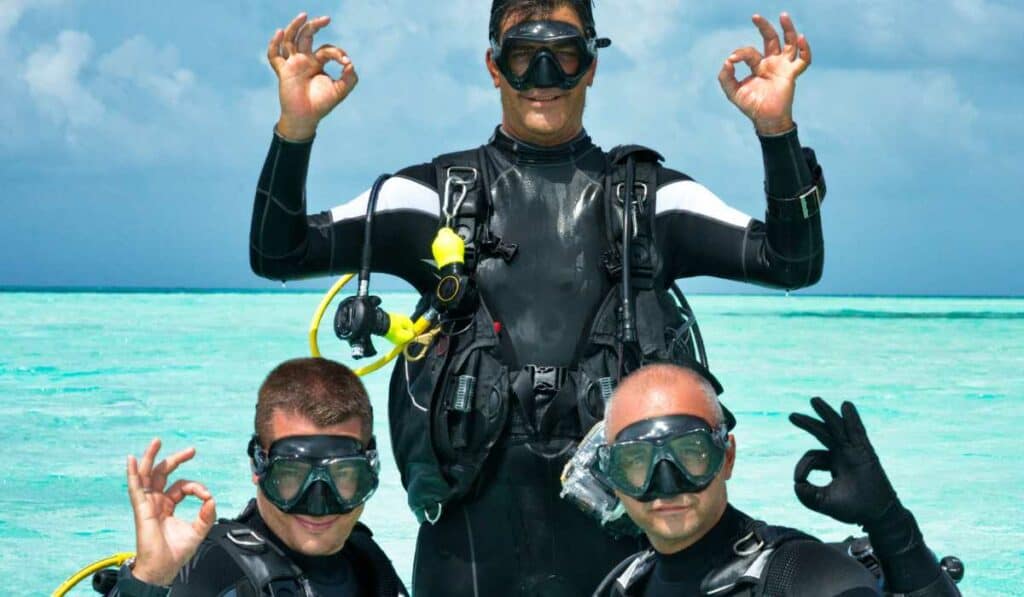
The history of scuba diving is a fascinating journey that takes us back to ancient times when people first started exploring the underwater world. Over the centuries, various methods and technologies have been developed to help humans dive deeper and stay submerged for longer periods. In this section, we will delve into the origins of scuba diving and how it has evolved over time.
Ancient Beginnings
As early as 500 BCE, Greek divers used hollow reeds as snorkels to breathe while they were underwater collecting sponges or hunting for food. The famous philosopher Aristotle even mentioned these early divers in his writings (source). Fast forward to the 16th century, when Leonardo da Vinci designed some rudimentary diving equipment such as air tubes connected to a float on the surface.
The Birth of Modern Scuba Diving
Inspired by earlier inventions like Da Vinci’s designs and other crude devices from previous centuries, modern scuba diving truly began in the late 19th century with inventors like Benoit Rouquayrol and Auguste Denayrouze creating an apparatus called the “Aerophore.” This device allowed divers to carry compressed air tanks on their backs while being able to regulate their breathing through a mouthpiece (source). In 1943, Jacques-Yves Cousteau and his collaborator developed the Aqua-Lung, thus making recreational scuba diving more accessible.
- 500 BCE: Greek divers use hollow reeds as snorkels.
- 16th century: Leonardo da Vinci designs rudimentary diving equipment.
- Late 19th century: Benoit Rouquayrol and Auguste Denayrouze invent the Aerophore.
- 1943: Jacques-Yves Cousteau co-invents the Aqua-Lung, making scuba diving more accessible for recreational purposes.
The invention of the Aqua-Lung revolutionized underwater exploration by allowing divers to stay submerged for extended periods without being tethered to a surface air supply. This newfound freedom opened up a whole new world of possibilities for both scientific research and recreational enjoyment (source). As interest in scuba diving grew, so did advancements in technology and safety measures that have made it an increasingly popular outdoor activity today at places like SunWaterDirt.
Click here to read about Ultimate Guide to Scuba Diving Gear
Military Applications
Scuba diving has been a key component of military operations since antiquity, from the Italian frogmen’s use of closed-circuit rebreathers in World War II to US Navy SEALs’ utilization of advanced dive gear during the Cold War. In World War II, Italian frogmen used closed-circuit rebreathers (which recycle exhaled gas) to carry out covert missions against enemy ships. Similarly, during the Cold War era, US Navy SEALs utilized advanced dive gear such as dry suits and underwater propulsion vehicles for their specialized missions (source). These military applications further contributed to technological advancements in scuba equipment that continue to benefit civilian divers today.
A Growing Community of Divers
Over the past several decades, scuba diving has grown from a niche activity to a mainstream outdoor pursuit enjoyed by millions of people worldwide. This growth can be attributed to advancements in dive gear technology, increased awareness about marine conservation efforts, and the establishment of organizations like PADI (Professional Association of Diving Instructors) that offer training and certification programs for divers at all skill levels.
The development of scuba diving from its ancient roots to the modern day has been a captivating journey, allowing humanity to experience Earth’s underwater realms. From ancient Greek snorkelers to modern-day recreational divers, this exciting journey continues as new generations discover the joys and challenges of exploring Earth’s final frontier.
The history of scuba diving is shrouded in obscurity, yet the insights gained by its original adventurers have been invaluable to contemporary divers. Tracing back the roots of scuba diving, we now explore some of these trailblazers who have been instrumental in crafting our current understanding.
Key Takeaway:
The history of scuba diving dates back to ancient times when Greek divers used hollow reeds as snorkels. Modern scuba diving began in the late 19th century with inventors creating an apparatus called the “Aerophore,” and Jacques-Yves Cousteau co-inventing the Aqua-Lung in 1943, making recreational scuba diving more accessible.
2. Early Pioneers of Scuba Diving
The annals of scuba diving are replete with remarkable individuals who have pushed the envelope and made essential strides toward advancing and popularizing this exciting underwater sport. Let’s dive into the lives and achievements of some early pioneers in scuba diving.
Jacques Cousteau and Emile Gagnan
Jacques Cousteau, a French naval officer, explorer, conservationist, filmmaker, innovator, scientist, photographer, author, and researcher, is often considered one of the most important figures in modern scuba diving history. In collaboration with engineer Emile Gagnan, they developed the first self-contained underwater breathing apparatus (SCUBA) called Aqua-Lung in 1943. This invention revolutionized diving by allowing divers to explore greater depths without being tethered to an air supply on the surface.
Hans Hass
Austrian biologist Hans Hass was another key figure during this era. He began exploring marine life using oxygen rebreathers back in 1937 before transitioning to open circuit systems like Aqua-Lung later on. His pioneering work included developing underwater photography techniques that allowed him to capture stunning images from his dives, which helped popularize scuba diving among wider audiences.
Lloyd Bridges – Sea Hunt TV Show
In addition to these inventors and explorers, celebrities also played a role in promoting recreational scuba diving. American actor Lloyd Bridges starred in the popular television series Sea Hunt, which aired from 1958 to 1961. The show followed the adventures of a former Navy frogman turned freelance scuba diver and featured numerous underwater scenes that showcased the excitement and beauty of diving.
Zale Parry
Zale Parry, an accomplished diver, was another early advocate for recreational scuba diving. She became one of the first female certified scuba instructors in 1955 and co-founded Scientific Underwater Research Enterprises (SURE), which developed innovative dive equipment such as wetsuits and full-face masks. Zale also appeared on various TV shows promoting diving safety, education, and conservation efforts.
The efforts of these early innovators have paved the way for today’s scuba diving, an exciting pastime experienced by millions globally.
The early innovators of scuba diving established a precedent for today’s recreational and professional divers, providing an avenue for underwater exploration. Now, let’s explore how scuba gear has evolved over time to keep up with advances in technology and safety standards.
Key Takeaway:
The chronicles of scuba diving are replete with impressive persons who pushed the envelope and made notable advances to its evolution. Jacques Cousteau and Emile Gagnan invented the first self-contained underwater breathing apparatus, while Hans Hass developed underwater photography techniques that helped popularize scuba diving among wider audiences. Celebrities like Lloyd Bridges and Zale Parry also played a role in promoting recreational scuba diving.
Click here to read about Where To Buy Your Scuba Gear: Online and Local Deals
3. The Evolution of Scuba Gear
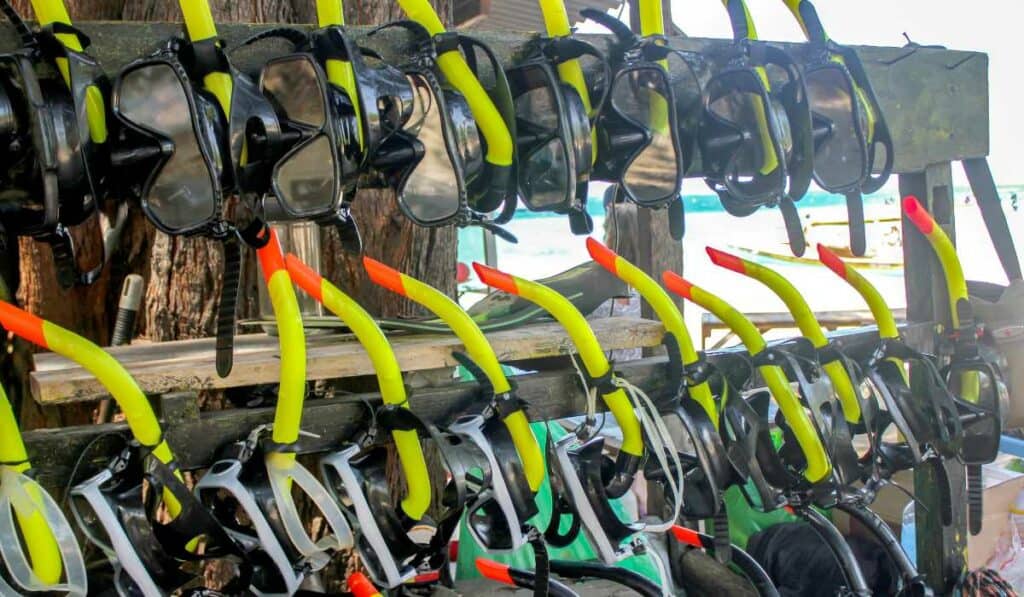
The development of scuba gear has progressed significantly since its primitive form, with modern technologies enhancing the safety and enjoyment of underwater exploration. In this section, we’ll explore how scuba gear has evolved over time.
Ancient Diving Equipment
Before modern scuba gear was developed, ancient civilizations like the Greeks and Romans used simple tools to aid in their underwater endeavors. For example, they utilized hollow reeds as snorkels or breathing tubes while submerged in shallow waters. However, these rudimentary devices were limited by depth and duration due to a lack of proper air supply.
The Birth of Modern Scuba Gear
In 1942, Jacques-Yves Cousteau and Emile Gagnan revolutionized the world of diving when they invented the Aqua-Lung, an open-circuit system that allowed divers to breathe compressed air from tanks on their backs while underwater. This groundbreaking invention enabled divers to stay submerged for longer periods without needing surface support systems such as hoses connected to boats.
- Regulators: Over time, regulators have become more advanced with features like balanced diaphragms that provide consistent airflow regardless of tank pressure or depth.
- Buoyancy Control Devices (BCDs): BCDs help maintain neutral buoyancy throughout a dive by allowing divers to inflate or deflate them using inflator buttons on their vests.
- Dive Computers: These essential gadgets monitor critical information such as depth, dive time remaining based on nitrogen absorption rates into body tissues during ascent/descent, and safety stop requirements.
- Wetsuits and Drysuits: Modern wetsuits are made from materials like neoprene that provide thermal insulation to keep divers warm in cold water. Drysuits offer even more protection by sealing out water completely with watertight zippers and seals around the neck, wrists, and ankles.
The Future of Scuba Gear
Scuba equipment is advancing with the times, becoming more and more advanced. For example, rebreather systems, which recycle exhaled air by removing carbon dioxide and replenishing oxygen levels, allow for longer dive times without the need for large tanks. Additionally, innovations such as underwater scooters or propulsion vehicles enable divers to cover greater distances with less effort.
In conclusion, scuba diving has come a long way since its early history. Thanks to the ingenuity of diving pioneers like Jacques-Yves Cousteau and Emile Gagnan, modern scuba gear has made it possible for recreational divers to explore the underwater world with ease and safety. As technology continues to evolve, we can expect even more exciting advancements in the world of scuba diving.
Scuba gear has seen remarkable progress, with ongoing developments in materials, design, and safety. With a better appreciation of the development of scuba gear, let us now explore some renowned diving sites across the globe.
Key Takeaway:
The history of scuba diving is traced back to ancient civilizations, who used simple tools like hollow reeds as snorkels. The invention of modern scuba gear by Jacques-Yves Cousteau and Emile Gagnan in 1942 revolutionized the world of diving, enabling divers to stay submerged for longer periods without needing surface support systems such as hoses connected to boats. Scuba gear has evolved over time with advancements like balanced diaphragm regulators, buoyancy control devices (BCDs), dive computers, wetsuits, and drysuits.
4. Popular Destinations for Scuba Divers
For those eager to explore the deep blue sea, numerous renowned scuba diving sites exist around the world that can provide remarkable experiences for divers of all levels. From vibrant coral reefs teeming with marine life to mysterious shipwrecks waiting to be discovered, these popular dive spots offer unforgettable experiences for both beginners and seasoned divers alike.
Australia’s Great Barrier Reef
The Great Barrier Reef is one of the most iconic scuba diving destinations in the world. Stretching out over an immense length of 1,400 miles along Australia’s eastern seaboard, this extraordinary biological system houses a multitude of species including fish, corals, and other marine life. With its crystal-clear waters and diverse underwater landscapes, it’s no wonder that this UNESCO World Heritage site attracts divers from all corners of the planet.
Belize’s Blue Hole
Located off the coast of Belize in Central America lies a natural phenomenon known as The Great Blue Hole. This enormous sinkhole measures over 980 feet across and plunges more than 400 feet deep into turquoise Caribbean waters. The unique geological formation offers an awe-inspiring experience for advanced divers who can explore its dark depths while encountering various shark species like hammerheads or bull sharks.
Egypt’s Red Sea Reefs
Egypt’s Red Sea coastline boasts some incredible dive sites renowned for their colorful coral gardens and abundant marine life. Popular locations such as Ras Mohammed National Park or Brothers Islands offer divers the chance to spot everything from vibrant reef fish and sea turtles to large pelagic species like manta rays, dolphins, and even whale sharks.
Indonesia’s Raja Ampat
Often referred to as the “Amazon of the Seas,” Raja Ampat is an archipelago in Indonesia known for its staggering biodiversity. With over 1,500 islands surrounded by pristine coral reefs, this remote destination offers some of the most spectacular scuba diving experiences on Earth. Divers can expect encounters with rare marine creatures such as pygmy seahorses or wobbegong sharks while exploring these vibrant underwater landscapes.
Mexico’s Cozumel Island
Famed for its crystal-clear waters and stunning coral formations, Cozumel Island off Mexico’s Yucatan Peninsula is a favorite among scuba enthusiasts worldwide. The island boasts numerous dive sites suitable for all skill levels where you can swim alongside colorful tropical fish, nurse sharks, or even spot eagle rays gracefully gliding through the water.
No matter which destination you choose for your next scuba diving adventure, be prepared to immerse yourself in a world filled with wonder and beauty that will leave lasting memories long after you’ve surfaced back onto dry land.
Scuba diving is a widely enjoyed pursuit, with numerous thrilling spots to investigate. Before setting off, familiarizing oneself with the safety protocols of scuba diving is essential to guarantee a secure and pleasurable experience.
Key Takeaway:
Outstanding scuba diving spots globally, such as the Great Barrier Reef in Australia, Belize’s Blue Hole, Egypt’s Red Sea coral reefs, Raja Ampat of Indonesia, and Cozumel Island in Mexico are featured. These locations offer breathtaking underwater experiences for divers of all skill levels with diverse marine life and stunning coral formations to explore.
5 Safety Tips for Scuba Divers
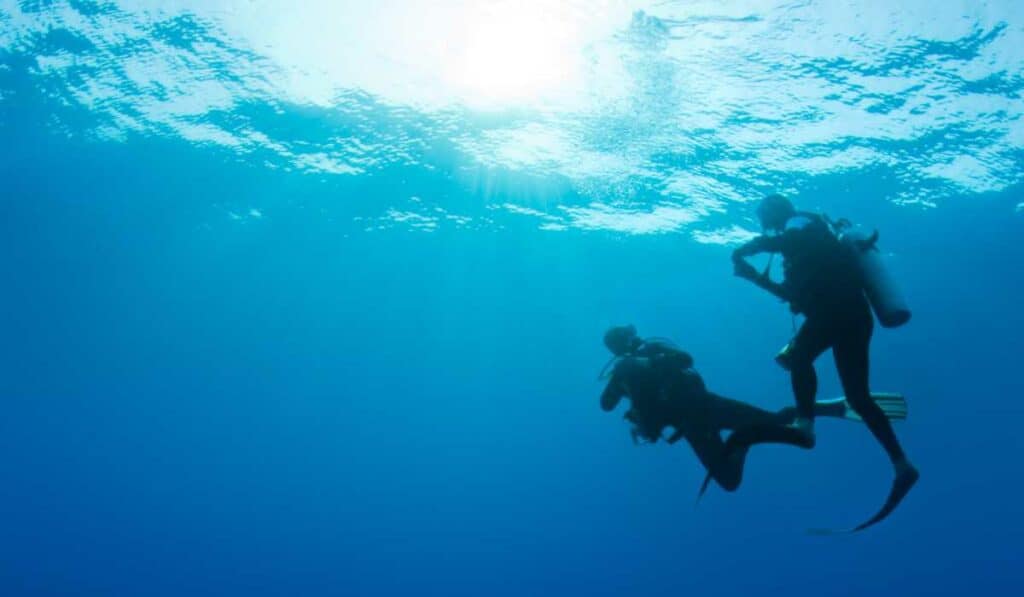
To maximize your safety while enjoying the underwater world, it is important to adhere to some essential scuba diving tips. Ensuring your safety while exploring the underwater world should be a top priority. Here are some essential safety tips that every scuba diver should follow:
Click here to read about Wet Suits vs Dry Suits – Picking The Right Scuba Suit
Choose the Right Dive Buddy
Finding a reliable dive buddy is crucial to ensuring your safety during dives. Make sure you choose someone who has similar experience levels and shares your interests in diving activities.
Maintain Your Equipment Properly
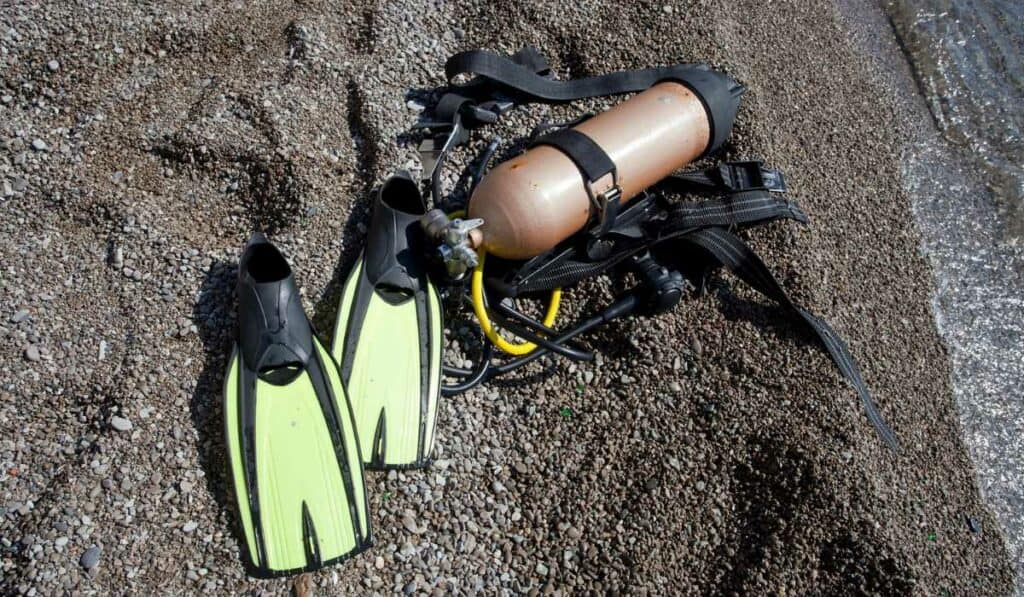
Maintain your scuba gear vigilantly to ensure it is functioning properly and safely. Learn how to properly clean, store, and repair each piece of equipment by following manufacturer guidelines or seeking professional assistance if needed.
- Dive Computer: Ensure that your dive computer’s battery is charged before each dive and check for any damaged or malfunctioning parts.
- Air Tanks: Inspect tanks for dents or rust spots before use; have them serviced annually by a certified technician.
- Buoyancy Control Device (BCD): Check all straps, buckles, hoses, inflator mechanisms, dump valves – everything.
- Drysuits/Wetsuits: Look out for tears or holes in suits as well as damaged zippers/seals which can compromise insulation properties.
Educate Yourself About Local Conditions & Hazards
Prioritize researching the local diving conditions and potential hazards of your chosen dive site. This includes understanding water temperature, currents, visibility, marine life behavior, and any specific regulations or restrictions in place.
Stay Within Your Limits
It’s essential to adhere to your individual capabilities when it comes to scuba diving, as surpassing them can lead to accidents and injuries. Don’t push yourself too hard or attempt dives that are beyond your skill level – this can lead to accidents and injuries. Always stay within the limits set by your certification level and experience.
Click here to read about Wearing Glasses While Scuba Diving 101
Plan Your Dive & Follow The Plan
A well-planned dive is a safe dive. Before entering the water, make sure you discuss with your buddy important details such as depth limits, air consumption rates, communication signals, emergency procedures (e.g., lost diver), ascent rates/times, etc. Once underwater stick to these plans for maximum safety.
Maintain Proper Buoyancy Control
Buoyancy control is key in ensuring a safe scuba diving experience. Make sure you’re familiar with how to adjust buoyancy using BCD inflator mechanisms or breath control techniques so that you can maintain neutral buoyancy throughout each stage of the dive.
By following these safeguards, you can make each dive a more secure and enjoyable experience.
Key Takeaway:
Choosing a suitable dive partner, keeping gear up-to-date, familiarizing oneself with the environment and potential risks, abiding by personal limitations, having a premeditated route, and adhering to buoyancy control are all necessary for an enjoyable yet secure scuba experience. By incorporating these safety tips into every dive you can enjoy all that scuba diving has to offer while minimizing risks.
FAQs about The History of Scuba Diving
What is the Brief History of Scuba Diving?
Modern scuba diving began in the 1940s when Jacques-Yves Cousteau and Emile Gagnan invented the Aqua-Lung, a self-contained underwater breathing apparatus (SCUBA).
Who First Invented Scuba Diving?
Jacques-Yves Cousteau and Emile Gagnan are credited with inventing modern scuba diving by developing the Aqua-Lung in 1942-43. This revolutionary device allowed divers to breathe compressed air while submerged, paving the way for recreational and professional underwater exploration.
How Was Scuba Diving Discovered?
Scuba diving was discovered through centuries of experimentation and innovation in underwater exploration techniques. Early methods included holding one’s breath or using rudimentary equipment like hollow reeds. The invention of the Aqua-Lung by Cousteau and Gagnan revolutionized this field, allowing people to explore deeper depths more safely.
How Has Scuba Diving Changed Over Time?
Over time, advancements in technology have improved safety measures, increased dive depth limits, enhanced communication capabilities between divers and surface support teams, and streamlined gear. Today’s equipment includes buoyancy control devices (BCDs), advanced regulators that deliver optimal airflow at varying depths, dive computers that monitor decompression limits, and digital cameras designed specifically for capturing stunning underwater images.
Conclusion
In conclusion, the history of scuba diving is a fascinating journey that began with early pioneers exploring the underwater world using primitive equipment. Over time, advancements in technology and gear have made it possible for recreational divers to safely explore the depths of our oceans. Nowadays, scuba diving continues to be a widely enjoyed activity that allows people to come into contact with oceanic creatures.

